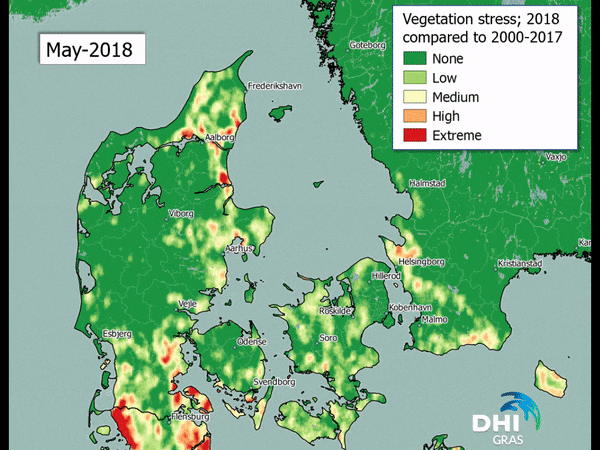Satellite-based evidence of the abnormal dry conditions in Denmark:
10 August 2018

The analysis depicts how the vegetation stress of May, June and July 2018 differ from the average ‘normal’ conditions of the same months (measured as an average of observed vegetation stress in the period 2000 to 2017). The vegetation stress is based on an assessment of the water availability where green colours indicate ‘no change from the normal conditions’ and red colours indicate ‘extreme worsening compared to the normal conditions’. Let’s break this down further.
May 2018, being mostly green, had normal conditions in most of the country if you compare it to the 18 previous years, although some parts already deviated from the average of previous years (these are the yellow to red colours you see). Moving on to June 2018 the colours have shifted, and we now see more areas affected by lack of water compared to previous years; the drought conditions are worsening and beginning to affect crops and natural vegetation. During July the picture changes completely. The heat wave and lack of rain continues and almost the entire country is now experiencing an extreme deviation from the period of 2000 to 2017 or put more simply: highly unusual and extreme drought.
These extreme deviations come at a cost. A prognosis done by a Danish agricultural journal, indicates that the expected Danish grain harvest will be more than 35% below the last five years’ average harvest. If the prognosis sticks this will give Danish farmers, the worst harvest recorded since 1976. In addition, the grass harvest for livestock fodder is expected to be halved, and the coming harvest of maize has been reduced by 25-30%; if the drought persists the output will be reduced even further.
Farmers dealing solely with livestock are also feeling the heat. The low supply of grains and other types of fodder is seeing a rise in prices which farmers are having a hard time to pay for.
All in all, this is estimated to cost the Danish agricultural sector minimum 6,4 billion Danish crowns. A government grant to help farmers is now being put in place and will among other things try to secure enough fodder for livestock and give more flexibility in relation to the sowing of catch crops. Our analysis clearly illustrates and documents the extreme conditions we have experienced this summer and that the vast majority of Denmark is affected by the ongoing lack of rain.
EOatDHI part of the DHI GROUP
gras@dhigroup.com
+45 4516 9100
Agern Alle 5,
2970 Hørsholm,
Denmark
CVR: 36466871
